Text
My Internship at the Centre for Cardiovascular Innovation — Centre d’Innovation Cardiovasculaire (CCI-CIC)
April 8, 2023


From March 21–24, 2023, I had the splendid opportunity to intern for a short period at the Centre for Cardiovascular Innovation, a clinical research centre operated by the University of British Columbia (UBC) Faculty of Medicine that facilitates regional and international clinical trials for cardiovascular researchers in BC investigating novel therapies for the treatment of certain cardiac conditions. This internship took place at Diamond Health Care Centre and Jim Pattison Pavilion at Vancouver General Hospital in Vancouver, Canada under the guidance of Dr. Brady Robinson. Below are some of the incredible activities that I did at CCI-CIC as well as my reflections on the experience.
Activities
Overview of CCI and the innovative projects that CCI researchers are working on to revolutionize cardiac procedures. This was led by Dr. Brady Robinson, Clinical Research Project Manager at CCI-CIC, whose current research project — called COMPLETE TAVR (CTAVR) — focuses on essentially combining Transcatheter Aortic Valve Replacement (TAVR) and Percutaneous Coronary Intervention (PCI) into a single procedure that can help patients with symptomatic aortic stenosis (AS) get treated while managing their concomitant coronary artery disease (CAD). Currently, patients who have CAD and have had PCI done in the past can not receive a TAVR to treat their AS, but CTAVR is set to make it possible to do so. The study is a stratified randomized trial led by the UBC Faculty of Medicine / Vancouver General Hospital with participating medical research institutions across Canada and the United States. 4,000 patients and 100 participating institutions are required for the study (∼200 patients and 60 institutions have been incorporated as of March 2023), and once complete, CTAVR would be the largest study of its kind in the world. Its results will be published in the prestigious New England Journal of Medicine and could have tremendous implications if successful.
Observing cardiac catheterization procedures in the Cardiac Catheterization Laboratory (Cath Lab) at Vancouver General Hospital. In these procedures, catheters were inserted through the patients’ common femoral artery and pushed up to the heart to assess blood flow in the coronary arteries with angiography (using X-Rays and contrast dye injected by the catheter). The catheters were also used for PCI: a coronary revascularization procedure performed by the insertion of stents that open up blocked coronary arteries in patients with CAD.
Assessing the suitability of several patients to participate in the CTAVR research study using inclusion and exclusion criteria assessing the patients’ current cardiac health (based on measures such as heart rhythm, blood pressure, jet velocity, LVEF, AVA area and index, lesions in coronary arteries, and NYHA Functional Classification during physical activity) and medical history (which entails past cardiac or other related medical conditions and operations).
Reflections
For me, the most influential part of my work experience at the UBC Centre for Cardiovascular Innovation was acquiring first-hand insight into COMPLETE TAVR, the flagship research project that the team of CCI researchers is working on. Once again, this developing research study is aiming to develop a method to treat a condition known as aortic stenosis in patients with coronary artery disease using cardiac catheterization, which dismisses the need for surgical procedures. As part of this experience, I got to observe the day-to-day tasks of Dr. Brady Robinson (as a reminder, the Clinical Research Project Manager of CTAVR), who regularly hosted meetings with scientists from different health institutions across Canada and the United States who are participating in the study and sought to recruit new patients for the study based on a set of inclusion/exclusion criteria to determine whether they are suitable to participate in CTAVR. As previously explained, as part of one of my favourite activities, I played the role of a research coordinator as I got to review these criteria and decide whether a set of four patients with different cardiac conditions and medical histories were eligible for the study. And of course, I had the opportunity to observe live cardiac catheterization procedures in the Cath Lab at Vancouver General Hospital, which was a tremendous experience!
During my time at CCI, I learned a lot about how new research studies are formulated and developed through an extensive process of research design development, patient and researcher recruitment, and innovation — one that may take several years to prepare and perform. I also learned how and for what purposes cardiac catheterizations are performed to diagnose and treat cardiovascular conditions like coronary artery disease, as well as how modifications to this cardiac procedure can open up a whole new scope of opportunities to treat cardiovascular diseases without the need for risky surgical operations. After completing this work experience, I have developed an even greater understanding and passion for medical research.
The biggest challenge I had during my placement was probably in the Cath Lab at VGH as I tried to understand step by step what was going on during the cardiac catheterization procedures through the monitors in the control room that displayed the angiographic images and ECG recordings. The angiographic images were black and white and — before the dye was injected by the catheter to highlight the coronary arteries — showed the heart, its arteries and the surrounding parts as faded objects, which sometimes made it difficult to identify where the catheter was during the process and thus what exactly was happening at each stage of the catheterization. The way I overcame this challenge was by simply asking the specialists in the control room to explain to me exactly what I was looking at on the angiogram as well as what was going on at each step, whether it was the insertion of the catheter through the aortic arch and into the heart or the injection of iodine dye into the coronary arteries (a more visually prominent step). Always satisfy your curiosity by asking questions, which in turn will satisfy your thirst for knowledge!
Conclusion & Appreciation
My goals for this placement were to deeply explore some of the innovative research taking place at CCI and acquire experiential exposure to the process of research in medicine, which I would love to pursue in the future. I have certainly achieved these goals as I am now much more aware of the large-scale preparation that goes into making studies like COMPLETE TAVR possible.
I sincerely thank Dr. Brady Robinson for spending time off his busy schedule to show me around and teach me about CCI as well as the COMPLETE TAVR project and Dr. Jacqueline Saw for demonstrating first-hand how cardiac catheterizations work in the Cath Lab at VGH. This work experience certainly wouldn’t be so rewarding without them.
I laud the efforts being made by researchers at CCI-CIC to innovate in the field of Clinical Cardiology and wish them the greatest success in the future.
CCI-CIC website: https://cci-cic.org
#cardiology#clinical medicine#research#innovation#medical research#medicine#cardiovascular#cardiachealth#education
0 notes
Text
The VEGF Molecular Signalling Pathway Mechanism Explained
By Amirali Banani
February 28, 2023

The PLC-γ-PKC-MAPK Pathway (simplified diagram sketched by Amirali Banani)
Vascular endothelial growth factor-A (VEGF-A) is essential for endothelial cell functions associated with angiogenesis (1). The signalling pathway begins with the binding of VEGF Receptors (VEGFR) to the VEGF cytokine to form a homodimer, a process known as Dimerization (2). The binding of a VEGF molecule to two VEGFR molecules induces the transphosphorylation of the intracellular domains of the receptors, leading to signal transduction (2, 3). In this section, we will be investigating the most prominent ligand-receptor complex in the VEGF System: VEGF-A/VEGFR2. VEGFR2, the major signal transducer for angiogenesis, is involved in the phospholipase C-γ-protein kinase C-mitogen-activated protein kinase (PLC-γ-PKC-MAPK) pathway, which is the pathway of interest that will be explained in this section (4). In this system, the VEGF-A molecule binds to and dimerizes VEGFR-1 and VEGFR-2, and signal transduction networks initiated by the VEGF-A/VEGFR2 complex promote angiogenesis, vascular permeability, as well as endothelial cell survival, migration, and proliferation (1,3,5). The dimerization of VEGFR-1 and VEGFR-2 as well as the transphosphorylation between the receptors’ intracellular kinase domains is followed by the activation of the VEGF Receptor Tyrosine Kinase (RTK) which induces the phosphorylation of an effector known as phospholipase C — gamma (PLC-γ) (5,6). After that, PLC-γ initiates a downstream intracellular signalling cascade that is facilitated by the sequential phosphorylation of a series of proteins called second messengers (6). The intracellular signal transduction process is regulated by several kinases of the MAPK pathway which phosphorylate and activate the downstream second messenger proteins, following the order: Ras-Raf-MEK-ERK (7,8). The Ras/Raf/MAPK (MEK)/ERK pathway is the most important signalling cascade among all MAPK signal transduction pathways and plays a paramount role in the survival and development of malignant tumour cells (7). In the last step of the PLC-γ-PKC-MAPK pathway, activated ERK 1/2 phosphorylates another kinase called RSK and both molecules travel to the nucleus of the vascular endothelial cell to activate multiple transcription factors which leads to effector protein synthesis, thus promoting cell proliferation and survival, and ultimately resulting in angiogenesis (9). Therefore, it can be observed through the PLC-γ-PKC-MAPK pathway that the hyperactivation of the expression of ERK 1/2 plays a crucial role in the development and progression of cancer through the promotion of rapid — and most of all aberrant — tumour neovascularization (10).
References
1. Abhinand C, Raju R, Soumya S, Arya P, Sudhakaran P. VEGF-A/VEGFR2 signaling network in endothelial cells relevant to angiogenesis. Journal of Cell Communication and Signaling. 2016;10(4):347–354.
2. Mac Gabhann F, Popel A. Dimerization of VEGF receptors and implications for signal transduction: A computational study. Biophysical Chemistry. 2007;128(2–3):125–139.
3. Shibuya M. Vascular Endothelial Growth Factor (VEGF) and Its Receptor (VEGFR) Signaling in Angiogenesis: A Crucial Target for Anti- and Pro-Angiogenic Therapies. Genes & Cancer. 2011;2(12):1097–1105.
4. Shibuya M. VEGFR and Type-V RTK Activation and Signaling. Cold Spring Harbor Perspectives in Biology. 2013;5(10):a009092-a009092.
5. Koch S, Claesson-Welsh L. Signal Transduction by Vascular Endothelial Growth Factor Receptors. Cold Spring Harbor Perspectives in Medicine. 2012;2(7):a006502-a006502.
6. Lawson N. phospholipase C gamma-1 is required downstream of vascular endothelial growth factor during arterial development. Genes & Development. 2003;17(>11):1346–1351.
7. Kowanetz M, Ferrara N. Vascular Endothelial Growth Factor Signaling Pathways: Therapeutic Perspective: Fig. 1. Clinical Cancer Research. 2006;12(17):5018–5022.
8. Li L, Zhao G, Shi Z, Qi L, Zhou L, Fu Z. The Ras/Raf/MEK/ERK signaling pathway and its role in the occurrence and development of HCC. Oncology Letters. 2016;12(5):3045–3050.
9. Mebratu Y, Tesfaigzi Y. How ERK1/2 activation controls cell proliferation and cell death: Is subcellular localization the answer?. Cell Cycle. 2009;8(8):1168–1175.
10. Guo Y, Pan W, Liu S, Shen Z, Xu Y, Hu L. ERK/MAPK signalling pathway and tumorigenesis (Review). Experimental and Therapeutic Medicine. 2020;.
#molecular biology#oncology#research#medicine#cell signaling#clinical medicine#therapeutics#experimental#cytology
0 notes
Text
How The Novel COVID-19 mRNA Vaccine Works
The new mRNA technology in Vaccinology - developed by Pfizer BioNTech and Moderna - can radically transform how scientists develop vaccines against other mRNA-based pathogenic viruses in the future, and more importantly, this new class of vaccines has proven to be more effective than traditional vaccines - even against multiple viral variants! The future is truly bright in medicine and biotechnology 💉🧬🦠
All illustrations, presentation design, script, and voiceover were produced by Amirali Banani
Sources: “B Lymphocyte Differentiation.” B Lymphocyte Differentiation - an Overview | ScienceDirect Topics, https://www.sciencedirect.com/topics/....
Cen.acs.org, https://cen.acs.org/pharmaceuticals/d....
“How Do Covid-19 Mrna Vaccines Work?” WebMD, WebMD, https://www.webmd.com/vaccines/covid-....
“How Do Different Types of Covid-19 Vaccines Work?” Mayo Clinic, Mayo Foundation for Medical Education and Research, 18 Jan. 2022, https://www.mayoclinic.org/diseases-c....
“How Do Mrna Vaccines Work?” Medical News Today, MediLexicon International, https://www.medicalnewstoday.com/arti....
LeBien, Tucker W., and Thomas F. Tedder. “B Lymphocytes: How They Develop and Function.” American Society of Hematology, American Society of Hematology, 1 Sept. 2008, https://ashpublications.org/blood/art....
“Overview of Translation (Article).” Khan Academy, Khan Academy, https://www.khanacademy.org/science/a....
Rijkers, Ger T, et al. “Antigen Presentation of Mrna-Based and Virus-Vectored SARS-COV-2 Vaccines.” Vaccines, MDPI, 3 Aug. 2021, https://www.ncbi.nlm.nih.gov/pmc/arti....
#mrna technology#vaccine#covid vaccine#covid19#public health#virology#pharmacology#healthcare#biotechnology
0 notes
Text
The Importance of Soft Skills in Medical Professionals
Amirali Banani
February 21, 2023

As people who serve society by prolonging and saving lives, medical professionals must possess and master certain soft skills to be successful in diagnosing and treating their patients. These soft skills often come with experience and are essential to improving a doctor’s ability to work with others as well as to perform their operations more efficiently. There are four soft skills in particular that shape a professional doctor and contribute significantly to their success.
A key soft skill that all medics must possess is collaboration. All doctors must be able to collaborate with each other to perform certain tasks as many operations and the handling of certain materials can not be done independently. In fact, one study conducted in 2012 which involved the NHS showed that collaboration significantly improves the quality of medical care by doctors [1]. Whether it is to enhance the care provided by medics or their productivity, being able to collaborate is a soft skill of paramount significance for all medics. Due to their demanding and stressful jobs, medical professionals must be able to handle the stress that they face at work to be able to focus when performing operations and effectively treat their patients, which is why stress-management is another very important soft skill for medics. Another study published in 2016 on the “burnout of doctors” found that while stress could be a motivating factor, if it goes beyond the optimal level, it could significantly impede on the performance of a medic [2] — ultimately speaking to how incredibly important stress-management is in the healthcare sector.
An experienced, accomplished doctor must be able to critically assess the health of patients when diagnosing and treating their disorders, which brings us to our third crucial soft skill: critical thinking. According to a 2017 report published in The BMJ, physicians who are proficient in thinking critically are better at making the right clinical decisions and provide the best treatment in the patient care process [3]. Whether it is prescribing the optimal dosage of a medication or mapping out the process to surgically remove a tumour in a safe manner, the importance of critical thinking skills in the healthcare setting can not be understated. Being a doctor is all about solving problems — which ultimately comes through treating and curing patients of their diseases — and this brings us to arguably the most significant soft skill for all medical professionals: problem-solving. A book titled “Problem Solving in Clinical Medicine (3rd edition)” explains, based on the results of several studies, that doctors who followed clinical techniques with a “problem-solving approach” to treat their patients often observed better outcomes in their treatments [4]. Medical professionals must view problems not as obstacles, but as valuable opportunities to improve the health of people.
The soft skills mentioned above are personal attributes that influence how well medical professionals can work and interact with others. These skills allow them to establish healthy relationships with patients and colleagues, create trust and reliability, work effectively both independently and in teams, and make the correct decisions when diagnosing and treating patients. The most successful and talented doctors have mastered these skills through clinical practice and experience, blending in their capabilities and knowledge to treat patients at the highest level of care.
Bibliography
[1] Green, B., “Collaboration can bring improvements in the quality and productivity of care”, 31–5–2012, https://www.hsj.co.uk/collaboration-can-bring-improvements-in-the-quality-and-productivity-of-care/5044853.article, (Accessed 14–12–2021)
[2] Kumar, S., “Burnout of Doctors: Prevalence, Prevention, and Intervention”, PubMed Central 4(3):37 (2016), https://www.ncbi.nlm.nih.gov/pmc/articles/PMC5041038/, (Accessed 17–12��2021)
[3] Sharples, Jonathan M, et al. “Critical Thinking in Healthcare and Education.” The British Medical Journal Publishing Group, 16–5–2017, https://www.bmj.com/content/357/bmj.j2234.full, (Accessed 18–12–2021)
[4] Cutler, Paul. Problem Solving in Clinical Medicine: From Data to Diagnosis, 3rd edition, Williams & Wilkins, 1988, p. 38
0 notes
Text
What is LASIK (Laser-Assisted In Situ Keratomileusis) and How is it Performed?
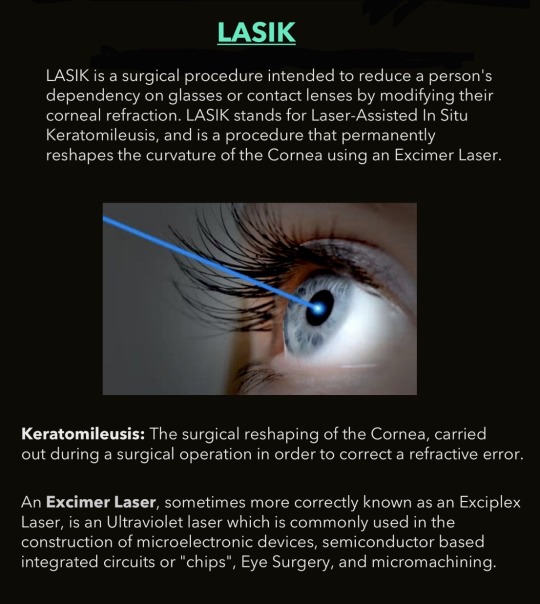

0 notes
Text
The Field of Medicine With The Greatest Impact on Society
Amirali Banani
February 14, 2023
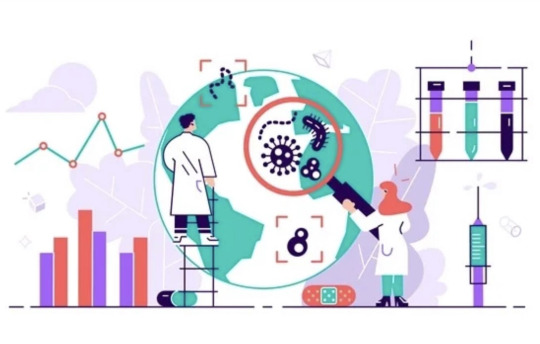
Medicine has always had a profound impact on society and the health of human beings. Driven by science and clever discoveries, medicine has prolonged and enriched the quality of the lives of mankind, and each branch of medicine has its own unique influence on society. There is one medical specialty though in particular that has the greatest impact on society, leading us through global pandemics and pushing the boundaries of biostatistical analysis investigating the sources and causes of diseases, their growth and transmission, and strategies for their regulation: Epidemiology (Community medicine). This medical specialty serves to protect the health of human beings and inform society about factors that can both deteriorate and enhance health.
Epidemiologists play a crucial role in protecting the health of citizens. According to the CDC, epidemiologists use descriptive and analytical epidemiology along with experience, epidemiologic judgement, and understanding of local conditions in “diagnosing” the health of a community and proposing appropriate, practical and acceptable public health interventions to control and prevent disease in the community. Public health professionals can then utilize these vital intervention proposals proposed by epidemiologists to develop methods to intervene in the proliferation of diseases by implementing operative disease preventative measures in society. Experts suggest that medical epidemiologists have added 25 years to the average life expectancy of people living in the United States since 1947. Without the tireless efforts of epidemiologists in protecting the health of human beings, millions of more lives would have been lost to pandemics and other global health crises that have occurred within the past several decades.
An article published by the Japan Epidemiological Association in 2015 states that the major objective of epidemiology is to contribute to fulfilling the definition of public health as “a science and art to promote health and prevent disease by organized effort of society”. With thousands of medical and biostatistical reports being published every day by epidemiologists, epidemiology has proven itself vital in the field of medicine and society as a study which links several disciplines that altogether provide essential data and information for mankind to be informed of health risks associated with various aggravating health factors, as well as practices to ameliorate lifestyle by enhancing mental and physical well-being. A report published on Columbia Public Health indicates that the field has made some truly impressive contributions to humanity, including the eradication of smallpox, fluoridation of drinking water, improved motor vehicle safety (for environmental health concerns), and recognition of tobacco as a health hazard. With such contributions, it’s not surprising that the discipline has saved so many lives through preventative and health-improving initiatives that have been developed as a result of extensive research and analysis.
Epidemiology is a medical discipline that is often overlooked by many, though its significance in civilization and in protecting the health of human beings cannot be understated. From my standpoint, it’s essentially the branch of medicine that forms the backbone of health care systems across the world, making it integral to society. Not only do epidemiologists lead humanity through devastating pandemics, they also fuel society with health-enhancing publications and set guidelines to better protect the health of people. For decades, epidemiology has guarded the health of human beings from the most severe health crises, and it continues to do so today.
Bibliography
Branas, C., “The Future of Epidemiology: World Class Science, Real World Impact”, 23–11–2020,www.publichealth.columbia.edu/academics/departments/epidemiology/who-we-are/message-chair/future-epidemiology-world-class-science-real-world-impact, (Accessed 18–12–2020).
Dicker, R.C. Principles of Epidemiology, 2nd edition, Atlanta: Centers for Disease Control and Prevention, 2006, p. 3.
“Epidemiology is a science of high importance”, Nature Communications 9:1703 (2018),
https://www.nature.com/articles/s41467-018-04243-3, (Accessed 27–11–2020).
Gulis G. and Fujino Y., “Epidemiology, Population Health, and Health Impact Assessment”, Journal of Epidemiology, vol. 25, no. 3, 2015, pp. 179–180.
von dem Knesebeck, O., “Concepts of social epidemiology in health services research”, BMC Health Services Research 15:357 (2015), https://bmchealthservres.biomedcentral.com/articles/10.1186/s129
13–015–1020-z, (Accessed 13–12–2020).
0 notes
Text
Radioactive Decay
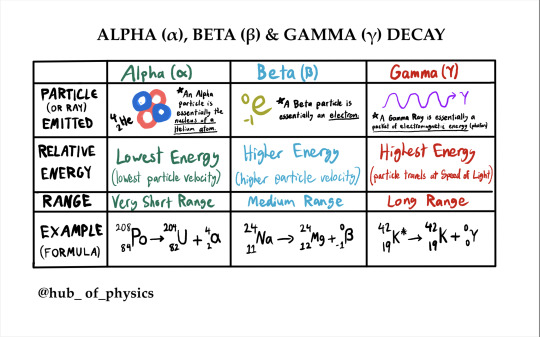
Alpha, Beta, and Gamma Decay are the three main forms of ionizing radiation caused by radioactive decay — the process by which unstable, radioactive nuclei emit radiation in the form of particles or rays to attain more stability. Alpha and Beta radiation come in the form of particles; an alpha particle is the nucleus of a helium atom while a beta particle is an electron. Gamma radiation, meanwhile, comes in the form of a photon (aka, a packet of electromagnetic energy), which is massless and has the highest energy. Due to its high ionizing energy, it has the potential to cause free radicals that can cause significant cellular damage in biological beings.
0 notes
Text
All About The Human Eye!
The eye is our most complex sensory organ. It consists of versatile structures such as the lens and iris that allow regulated amounts of light from varying distances to be focused on the retina – which converts the light into signals that are sent to the brain to be processed.

The main parts of the human eye represented on a cross-section illustrated transversally.
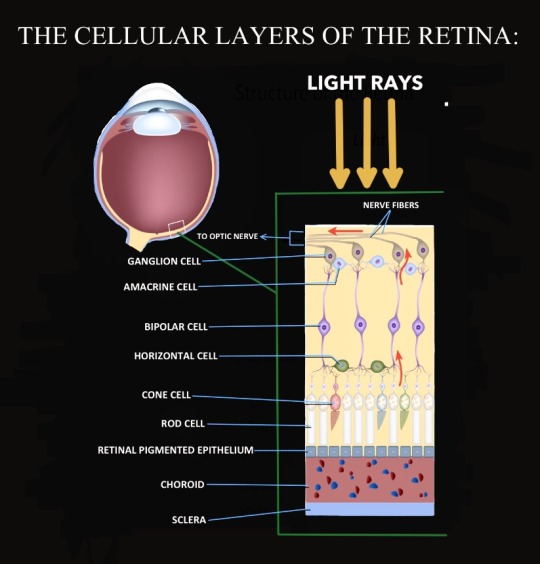
The cells of the retina, divided into 3 primary layers (from innermost to outermost):
Photoreceptor cell layer (rods and cones)
Bipolar cell layer (bipolar and horizontal cells)
Ganglion cell layer (ganglion and amacrine cells)
In the retina, there are 1.2 million ganglion cells, 6 million cones, and 120 rods spread across 10 layers of cells and 6 unique cell lines that work to convert light energy into electrical signals. These signals are gathered from all the cells and transmitted to the visual cortex inside the brain's occipital lobe via the optic nerve.
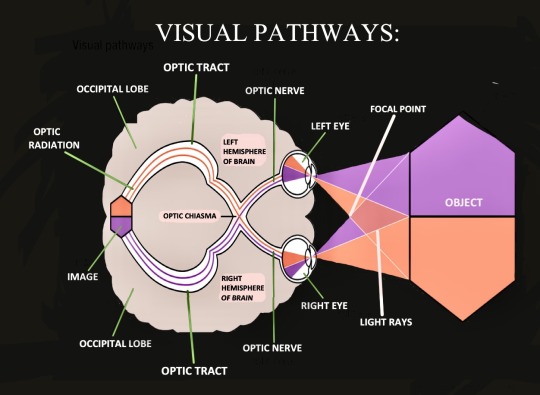
Light that enters our eyes from the left side of our visual field is processed in the right hemisphere of the brain while the light that enters our eyes from the right side of our visual field is processed in the brain's left hemisphere. This 'crisscrossing of visual fields', which takes place at the optic chiasma, results in a flipped image – which the brain automatically corrects.
6 notes
·
View notes
Text
Lessons From The COVID-19 Pandemic
Amirali Banani
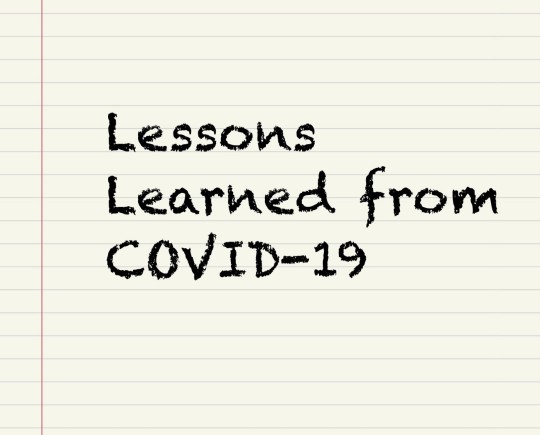
COVID-19 has been a struggle for all of us. The pandemic has not only caused physical pain in those who have been infected with the virus, but it has also been a mental burden that continues to become more agonizing as case counts rise, restrictions increase, and as we long more and more to see those whom we love. Despite the obvious negative experiences of COVID-19, the pandemic has helped us learn a plethora of new things and has given rise to new innovations and changes in perspectives of life. From better hygiene to online learning, the COVID-19 Pandemic has truly shaped a new lifestyle for us all.
While the pandemic has impeded progress in many industries, it has led to innovations that could revolutionize the way we live and allow us to be better prepared for the next global pandemic. One such innovation is the breakthrough mRNA Vaccine developed by Pfizer-BioNTech and Moderna. Compared to traditional vaccines, mRNA vaccines can generate stronger immunity as they stimulate the immune system to produce both antibodies and immune system killer cells – a double strike at the virus. This method of using the mRNA of the virus instead of introducing spike proteins into a patient’s body can also be applied in the creation of other vaccines to fight other viruses with higher efficacy. COVID-19 has certainly demonstrated that with teamwork in the scientific community, we can achieve anything. Additionally, the pandemic has led to the development of more efficient ventilators which can aid patients suffering from pulmonary and cardiovascular diseases better than ever before and substantially improved video conferencing which has enabled people across the world to connect in higher numbers with better quality, allowing students to continue learning, innovators to continue innovating, and families to continue seeing their loved ones virtually.
In addition to the numerous innovations that COVID-19 has led to, the pandemic has also taught us many important life lessons that we must all take some time to appreciate. Among the many lessons it has taught us however, one stands out the most: you never truly understand the value of something until you don’t have it. Before the pandemic, spending time with family and friends was a regular daily practice that we would do without much appreciation. Ever since the pandemic separated us from our loved ones, however, we only began to comprehend this significant lesson in its entirety. COVID-19 has taught us to enjoy and appreciate life while we can and to spend as much time as possible with those whom we love because spending quality time with family helps in coping with challenges, instills a feeling of security, fills one with confidence, and is not unlimited.
Furthermore, COVID-19 has conveyed an essential message that we should not take for granted: we need each other. Loneliness harms our health much more than we previously thought, and it’s only during the pandemic that many people came to realize this reality. We humans have always lived in groups from the beginning of our existence. We are collaborative beings who care for and require the help of one another to live and thrive. The pandemic has opened our eyes to the tragic consequences of isolation in a way that was incomprehensible before and has thus taught us to value each other more than anything else in the world.
Taking all things into consideration, when we look back at this pandemic in the future, we can see some significant positive outcomes that show the ingenuity of the human race, our altered but ultimately improved lifestyles, and most importantly, the essentiality of humans for each other. Of course, the COVID-19 Pandemic has overall been a negative experience for all of us, but the more important thing is to learn from its positives. When this pandemic officially ends, we can hopefully come back as stronger and more aware people than before with altered perspectives of life and greater appreciation for each other.
0 notes
Text
A quick, 1-minute animation about Dark Energy -> an invisible and rather unknown force that is forcing the universe to expand at an accelerated rate — even faster than the speed of light!
0 notes
Text
The [Indefinite] Standard Model of Particle Physics

Many of the scientific models that we follow — no matter how respected — are incomplete. The Standard Model of Particle Physics is no exception. In a field like Particle Physics in which there is still much uncertainty, it is no surprise that its standard model is still lacking.
2 notes
·
View notes
Text
Anatomy & Physiology of The Liver

Download this infographic here: https://drive.google.com/file/d/1KBZiuSZ7UrpY1ZoL23La4ZvhBgxEch7U/view
0 notes
Text
Classifying Matter

The matter that we know and interact with can be broadly divided into two main categories: pure substances and impure substances. Pure substances are made of only one type of substance, whereas impure substances consist of multiple substances mixed in some manner.
(click on image to view in higher quality)
1 note
·
View note
Text
The Lineage & Differentiation of Human Blood Cells
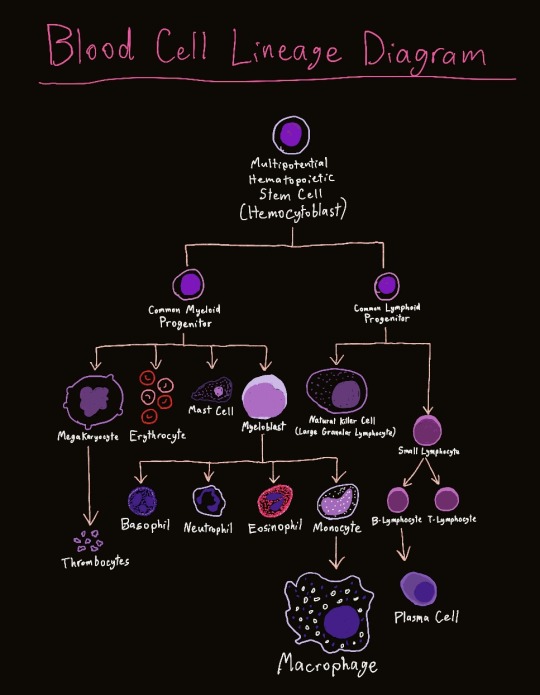
All blood cells originate from a hematopoietic stem cell known as a Hemocytoblast. Through multiple rounds of differentiation, this Hemocytoblast becomes erythrocytes, lymphocytes, thrombocytes, and every other type of blood cell that we know of.
11 notes
·
View notes
Text
All About Bacteria!

The basic anatomy of a bacterium

The different morphologies of bacteria
1 note
·
View note
Text
Major Differences Between Animal & Plant Cells

• Plant cells consist of a cell wall; animal cells do not
• Animal cells are flexible; plant cells are rigid
• Plant cells consist of one large vacuole; animal cells contain multiple small vacuoles
• Plant cells contain chlorophyll; animal cells do not
1 note
·
View note
Text
Infographic Demonstrating The Process of Nuclear Fission

Initiated by the collision of an incident neutron with a fissionable atomic nucleus, Fission is the process of continuously splitting nuclei—with each collision generating an enormous amount of energy.
(click on the image to view the infographic in higher quality)
0 notes